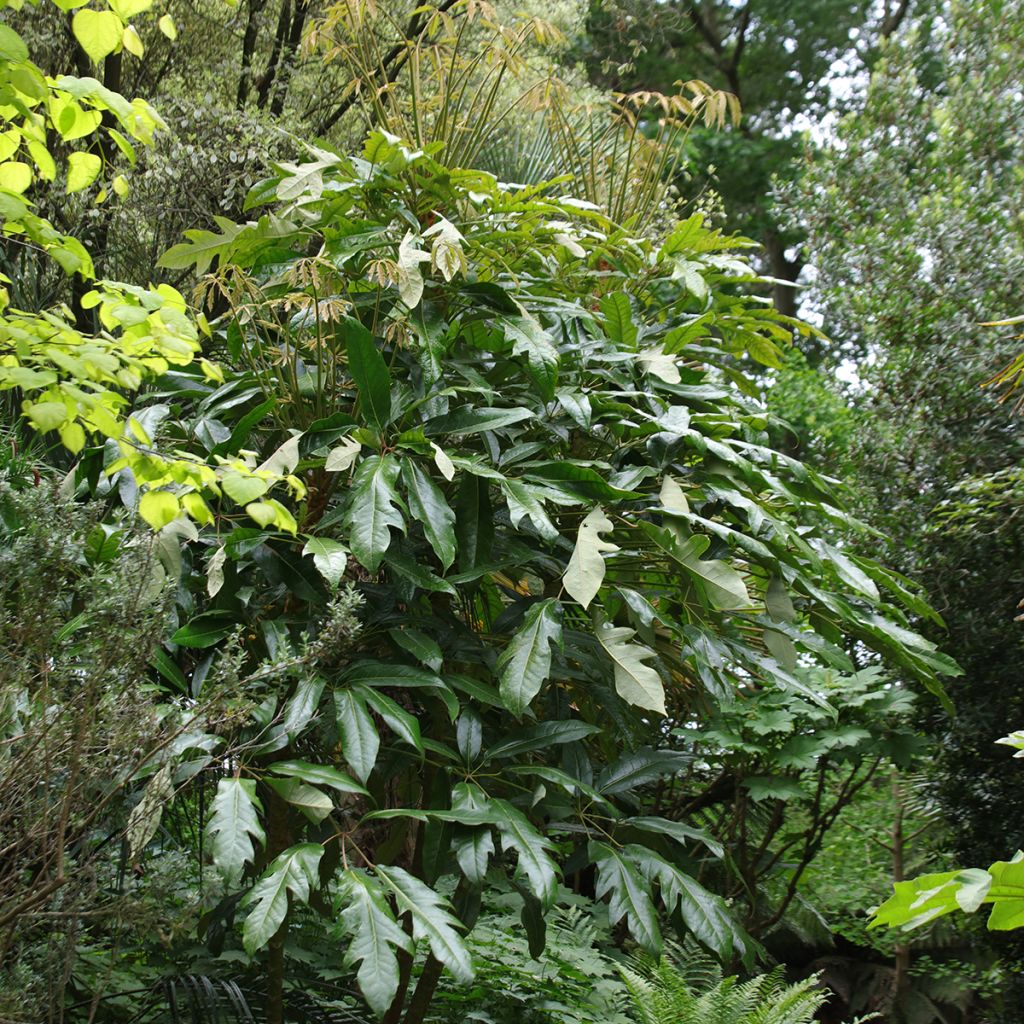

Schefflera delavayi
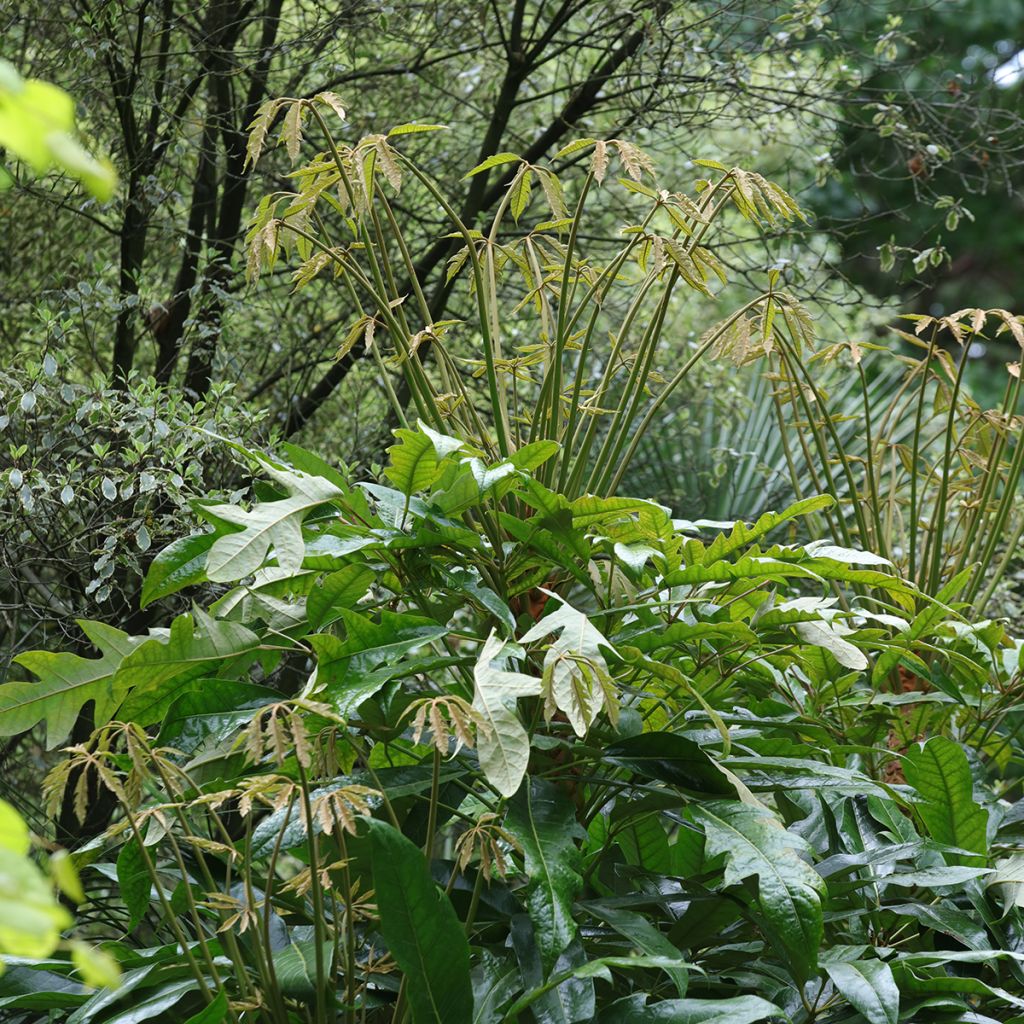

Schefflera delavayi
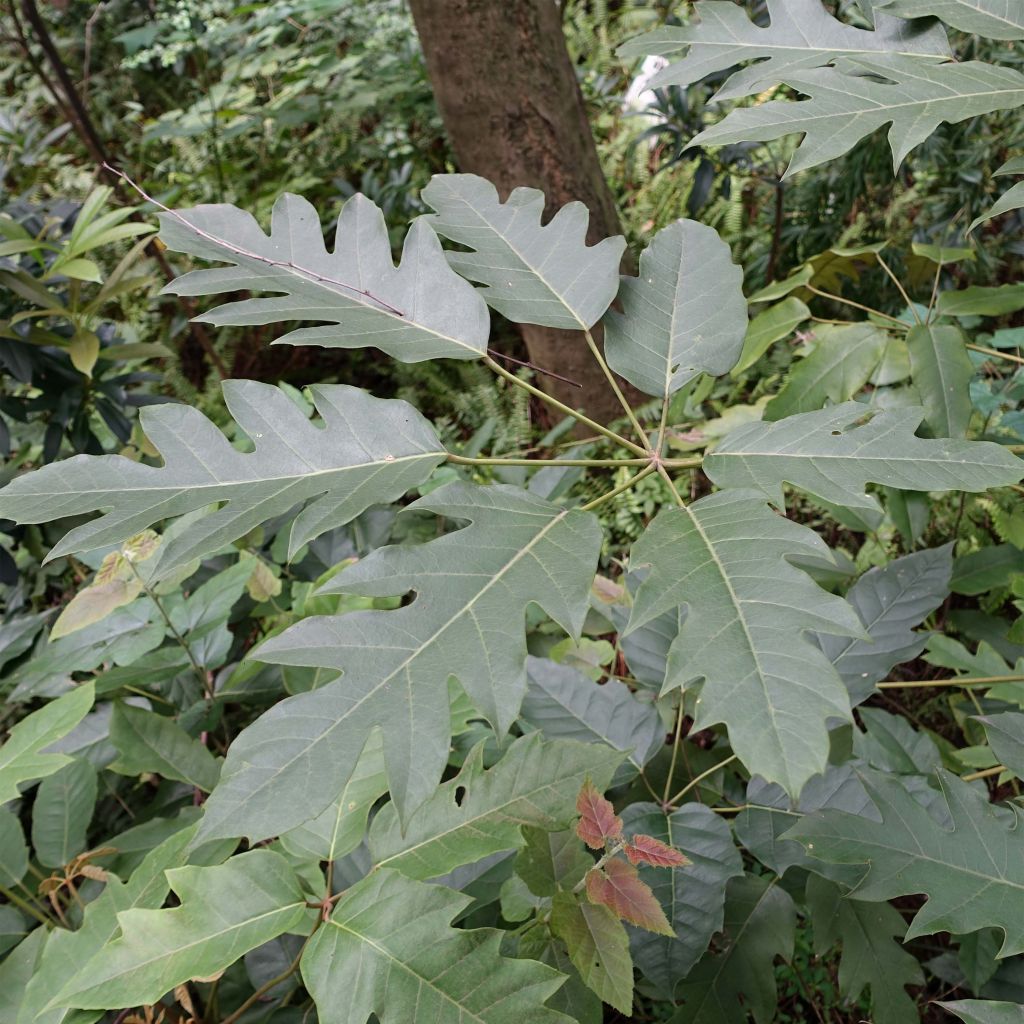

Schefflera delavayi
Schefflera delavayi
Schefflera delavayi
Delavay's Schefflera
This plant carries a 24 months recovery warranty
More information
We guarantee the quality of our plants for a full growing cycle, and will replace at our expense any plant that fails to recover under normal climatic and planting conditions.
From €5.90 for pickup delivery and €6.90 for home delivery
Express home delivery from €8.90.
Does this plant fit my garden?
Set up your Plantfit profile →
Description
Schefflera delavayi, related to our indoor scheffleras, is a botanical species native to the mountains of China and northern Vietnam. As such, it is a robust plant capable of withstanding short freezes of around -10°C (14°F). It is also a very ornamental evergreen bush, forming a superb lush bush with tiered branches adorned with beautifully cut foliage that curls under the effect of cold. In summer, it buzzes with bees with large white-cream panicles that will give way to clusters of black fruits. This amazing Schefflera deserves to be tried in mild climate gardens: give it partial shade and soft, moist but well-drained soil.
Delavay Schefflera belongs to the araliaceae family. It is found naturally in high-altitude forests in the south of China and northern Vietnam, not far from streams or in cool valleys. This plant appreciates fertile, humus-rich and moist soils, but adapts quite easily to any good garden soil. In China it grows in the humus of the undergrowth on a limestone subsoil. Little is known about the limits of this Schefflera, which is very rare in cultivation, especially in terms of hardiness.
It is a bush with a spread rounded habit, slightly weeping, reaching an average height of 2.50 m (8ft), or more than 3 m (10ft) in favourable regions, its spread will be approximately equal to its height. Its growth is more or less rapid depending on the growing conditions. The branches bear persistent leaves in the terminal part. Each leaf, sometimes reaching 40 cm (16in) in length, is divided into 5 elongated and leathery leaflets with a pointed tip, two smaller ones at the base, shiny dark green on the upper side, but lighter underneath. Like some Rhododendrons, the leaflets tend to curl slightly in on themselves under the bite of the cold. The very small flowers appear in summer, from June to August depending on the climate, and last for several weeks grouped in large upright and branched panicles of 25 to 50 cm (10 to 20in), appearing above the foliage. Small blackish fruits then follow.
Schefflera delavayi is undoubtedly a very beautiful bush for an exotic-inspired garden. Once established, it is superb as a standalone plant in a shaded area, or in a group. It is also interesting in association with trees and shrubs that also appreciate moist to wet soils such as hydrangeas, its Aralia cousins, or Colocasia. In a more exotic setting, choose to associate it with beautiful Asian plants, such as caramel tree, Japanese maple, Fatsia, or Arisaema for example. Maples and flowering dogwoods, often magnificent at the end of the season, are also very beautiful companions for this plant. Gardeners can also grow it in a large pot to protect during winter.
Report an error about the product description
Schefflera delavayi in pictures
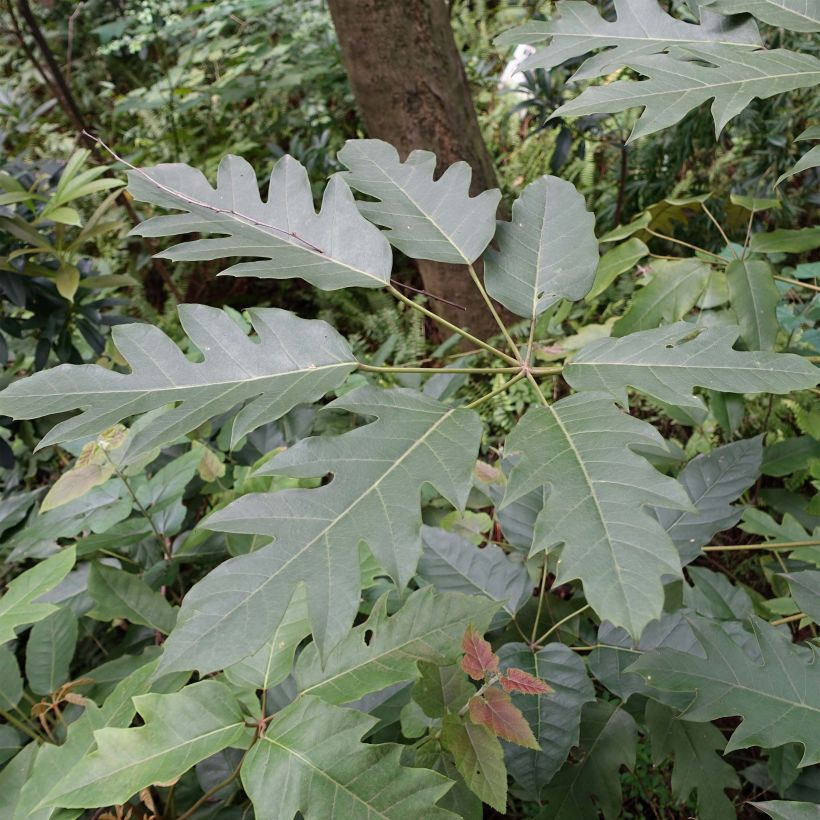

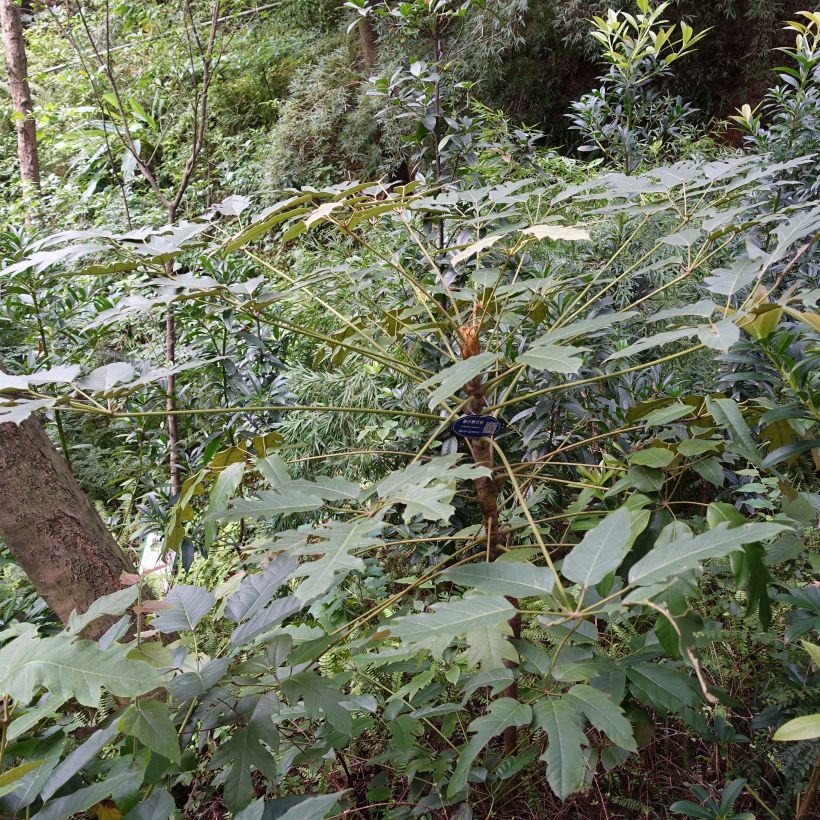

Plant habit
Flowering
Foliage
Botanical data
Schefflera
delavayi
Araliaceae
Delavay's Schefflera
China
Planting and care
Schefflera delavayi is fairly tolerant as regards soil, as long as it is flexible, well-drained, and remains moist. It dislikes intense sunlight and appreciates a semi-shaded exposure. Denser shade does not suit it, except perhaps in a very sunny hot climate. Care must be taken to install it sheltered from strong or drying winds to spare its ornamental foliage. It has been seen to withstand short frosts of around -10°C: perhaps even lower, depending on the soil, climate, and exposure.
Pot cultivation: choose a large container with drainage holes at the bottom. Place a layer of clay pebbles for drainage. Mix garden soil, leaf compost, and coarse sand. Pay attention to regular watering, especially in summer. Apply a slow-release fertilizer in spring and autumn. In cold regions, store your Schefflera in a very bright room, protected from severe frosts but with little or no heating.
Planting period
Intended location
Care
This item has not been reviewed yet - be the first to leave a review about it.
Haven't found what you were looking for?
Hardiness is the lowest winter temperature a plant can endure without suffering serious damage or even dying. However, hardiness is affected by location (a sheltered area, such as a patio), protection (winter cover) and soil type (hardiness is improved by well-drained soil).

Photo Sharing Terms & Conditions
In order to encourage gardeners to interact and share their experiences, Promesse de fleurs offers various media enabling content to be uploaded onto its Site - in particular via the ‘Photo sharing’ module.
The User agrees to refrain from:
- Posting any content that is illegal, prejudicial, insulting, racist, inciteful to hatred, revisionist, contrary to public decency, that infringes on privacy or on the privacy rights of third parties, in particular the publicity rights of persons and goods, intellectual property rights, or the right to privacy.
- Submitting content on behalf of a third party;
- Impersonate the identity of a third party and/or publish any personal information about a third party;
In general, the User undertakes to refrain from any unethical behaviour.
All Content (in particular text, comments, files, images, photos, videos, creative works, etc.), which may be subject to property or intellectual property rights, image or other private rights, shall remain the property of the User, subject to the limited rights granted by the terms of the licence granted by Promesse de fleurs as stated below. Users are at liberty to publish or not to publish such Content on the Site, notably via the ‘Photo Sharing’ facility, and accept that this Content shall be made public and freely accessible, notably on the Internet.
Users further acknowledge, undertake to have ,and guarantee that they hold all necessary rights and permissions to publish such material on the Site, in particular with regard to the legislation in force pertaining to any privacy, property, intellectual property, image, or contractual rights, or rights of any other nature. By publishing such Content on the Site, Users acknowledge accepting full liability as publishers of the Content within the meaning of the law, and grant Promesse de fleurs, free of charge, an inclusive, worldwide licence for the said Content for the entire duration of its publication, including all reproduction, representation, up/downloading, displaying, performing, transmission, and storage rights.
Users also grant permission for their name to be linked to the Content and accept that this link may not always be made available.
By engaging in posting material, Users consent to their Content becoming automatically accessible on the Internet, in particular on other sites and/or blogs and/or web pages of the Promesse de fleurs site, including in particular social pages and the Promesse de fleurs catalogue.
Users may secure the removal of entrusted content free of charge by issuing a simple request via our contact form.
The flowering period indicated on our website applies to countries and regions located in USDA zone 8 (France, the United Kingdom, Ireland, the Netherlands, etc.)
It will vary according to where you live:
- In zones 9 to 10 (Italy, Spain, Greece, etc.), flowering will occur about 2 to 4 weeks earlier.
- In zones 6 to 7 (Germany, Poland, Slovenia, and lower mountainous regions), flowering will be delayed by 2 to 3 weeks.
- In zone 5 (Central Europe, Scandinavia), blooming will be delayed by 3 to 5 weeks.
In temperate climates, pruning of spring-flowering shrubs (forsythia, spireas, etc.) should be done just after flowering.
Pruning of summer-flowering shrubs (Indian Lilac, Perovskia, etc.) can be done in winter or spring.
In cold regions as well as with frost-sensitive plants, avoid pruning too early when severe frosts may still occur.
The planting period indicated on our website applies to countries and regions located in USDA zone 8 (France, United Kingdom, Ireland, Netherlands).
It will vary according to where you live:
- In Mediterranean zones (Marseille, Madrid, Milan, etc.), autumn and winter are the best planting periods.
- In continental zones (Strasbourg, Munich, Vienna, etc.), delay planting by 2 to 3 weeks in spring and bring it forward by 2 to 4 weeks in autumn.
- In mountainous regions (the Alps, Pyrenees, Carpathians, etc.), it is best to plant in late spring (May-June) or late summer (August-September).
The harvesting period indicated on our website applies to countries and regions in USDA zone 8 (France, England, Ireland, the Netherlands).
In colder areas (Scandinavia, Poland, Austria...) fruit and vegetable harvests are likely to be delayed by 3-4 weeks.
In warmer areas (Italy, Spain, Greece, etc.), harvesting will probably take place earlier, depending on weather conditions.
The sowing periods indicated on our website apply to countries and regions within USDA Zone 8 (France, UK, Ireland, Netherlands).
In colder areas (Scandinavia, Poland, Austria...), delay any outdoor sowing by 3-4 weeks, or sow under glass.
In warmer climes (Italy, Spain, Greece, etc.), bring outdoor sowing forward by a few weeks.


































